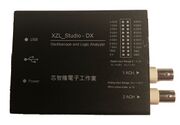Difference between revisions of "XZL Studio DX"
| Line 1: | Line 1: | ||
{{DISPLAYTITLE:XZL_Studio DX}} | {{DISPLAYTITLE:XZL_Studio DX}} | ||
{{Infobox logic analyzer | {{Infobox logic analyzer | ||
| image = | | image = [[File:XZL Studio-DX front.jpg|180px]] | ||
| name = XZL_Studio DX | | name = XZL_Studio DX | ||
| status = | | status = supported (digital part only) | ||
| source_code_dir = fx2lafw | | source_code_dir = fx2lafw | ||
| channels = 16 + 2 | | channels = 16 + 2 | ||
| Line 43: | Line 43: | ||
== Pin mapping == | == Pin mapping == | ||
Needed for use (I don't know how to remap pins yet) | |||
Current PIN meaning (latest software) | Current PIN meaning (latest software) | ||
| Line 174: | Line 176: | ||
[[Category:Oscilloscope]] | [[Category:Oscilloscope]] | ||
[[Category:Mixed-signal oscilloscope]] | [[Category:Mixed-signal oscilloscope]] | ||
[[Category: | [[Category:Supported]] | ||
Revision as of 09:56, 10 March 2018
 | |
| Status | supported (digital part only) |
|---|---|
| Source code | fx2lafw |
| Channels | 16 + 2 |
| Samplerate | 24MHz |
| Samplerate (state) | — |
| Triggers | none (SW-only) |
| Min/max voltage |
Digital 0 — 5.4V Analog ±10V |
| Threshold voltage | Fixed: VIH=1.4V, VIL=0.8V |
| Memory | none |
| Compression | none |
| Website | hotmcu.com |
The XZL_Studio DX is a USB-based, 16-channel logic analyzer with up to 24MHz sampling rate, and with 2 additional analog channels.
It is a clone of the CWAV USBee DX.
See XZL_Studio DX/Info for some more details (such as lsusb -vvv output) on the device.
Note: Due to the fact that this device has two FX2 chips behind a USB hub inside, this will need extra code to enumerate correctly in sigrok. Do you have this device? Let us know!
Hardware
- Main chip: 2x Cypress CY7C68013A-56LTXC (FX2LP)
- Analog-to-Digital converter: 2x Texas Instruments TLC5510I (SO 24pin package)
- I2C EEPROM: ATMLH136 24C02C M Y, place for second EEPROM chip reference.
- USB 2.0 Hub: SMSC USB2512A (QFN 36-pin package)
- Low-dropout voltage regulator: Advanced Monolithic Systems AMS1117-3.3
- CMOS Voltage Converter: 2x 7660 AIBAZ V01828A
- Crystal: 24MHz
- ...
Two jumpers:
- P1 jumper - WRITE PROTECT, Connects WP EEPROM pin [7] to Vcc. If pin is closed, Write Protection is enabled.
- P3 jumper - EEPROM CONNECTION, connects SDA EEPROM pin [5] to SDA pins on both CY7C68013A (if open there is no connection)
Extra info,
It looks that place for second eeprom is designed as backup memory. If P4 is closed, and P3 is open, then only spare memory is connected.
Pin mapping
Needed for use (I don't know how to remap pins yet)
Current PIN meaning (latest software)
| 4 | 15 |
| 5 | 14 |
| 6 | 13 |
| 7 | 8 |
| 3 | 9 |
| 2 | 10 |
| 1 | 11 |
| 0 | 12 |
| TRIG | GND |
| 5V | GND |
First FX2LP pin mappings
Responsible for all digital inputs (0-15) and TRIG. Now it works with latest software version, but channels numbers are scrambled:
| # | Pin | Destination | Remark |
|---|---|---|---|
| FD4 | 0 | digital input | |
| FD5 | 1 | digital input | |
| FD6 | 2 | digital input | |
| FD7 | 3 | digital input | |
| FD3 | 4 | digital input | |
| FD2 | 5 | digital input | |
| FD1 | 6 | digital input | |
| FD0 | 7 | digital input | |
| FD15 | 8 | digital input | |
| FD14 | 9 | digital input | |
| FD13 | a | digital input | |
| FD8 | b | digital input | |
| FD9 | c | digital input | |
| FD10 | d | digital input | |
| FD11 | e | digital input | |
| FD12 | f | digital input | |
| 36 | CTL0/FLAGA | TRIG | socket pin |
| 21 | Reserved | GND |
Second FX2LP pin mappings
Connected to both ADCs
FX2LP pin mappings
| # | Pin | Destination | Remark |
|---|---|---|---|
| 9 | RDY1/SLWR | ADC [1,2] CLK | ADC_clock, both ADC connected to single pin |
| 25-32 | FD0-FD7 | ADC CH1, D1-D8 | ADC_data for channel 1 |
| 42-56,1-3 | FD8-FD15 | ADC CH2, D1-D8 | ADC_data for channel 2 |
| 45 | PA5/FIFOADR1 | GND | gnd ? to check |
| 47 | PA7/*FLAGD/SLCS# | GND | gnd ? to check? probably can be used do distinguish chips |
TODO - check rest of the pins
EEPROM - connected to both (!) CY7C68013A processors
| # | EEPROM | Processor | |
|---|---|---|---|
| SDA | SDA | via jumper | |
| SCL | SCL |
Photos
Protocol
Since we use the open-source fx2lafw firmware for this device, we don't need to know the protocol.
Resources
TODO.




